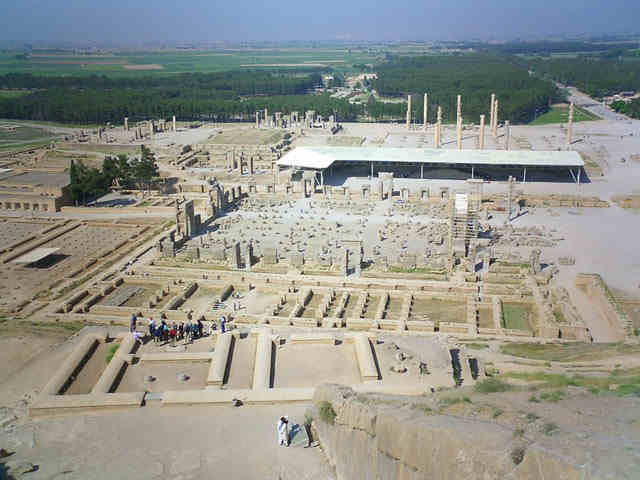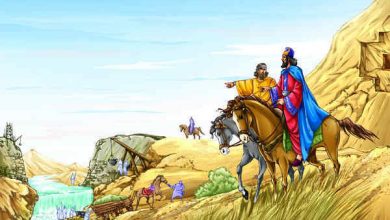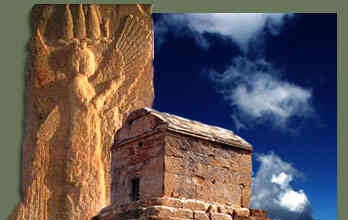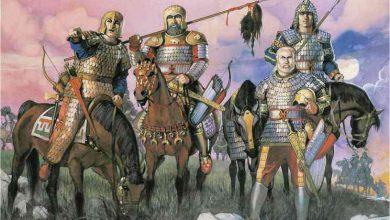A look at the myths of Iran
The first ruling dynasty in the mythological and epic history of Iran was the land of "Pishdadians".. Pishdad means "the first person who brought the law". In Ferdowsi's Shahnameh, the first king of Peshdada "Gyumarth" (What is inheritance?) (Kiomers) He was the first Aryan human being and the first ruler in Avesta and ancient texts, and according to mythological texts, he was the first male heir after Islam and the first "mardiane" woman.. After him, Houshang and Jamshid respectively reach Jahandari.
After defeating Jamshid, Dahhak Tazi ruled Iran for a while and captured Jamshid's children.. But Kaveh Ahangar and Fereydoun will suffer from rebellion. After Zahhak was imprisoned in Damavandkoh, Feridoon, Manouchehr, Nozer, Zab and Gershasab became rulers and chieftains.. After the decline of Peshdadyan, one of Manouchehr's descendants named Kiqbad, with the help of Rostam, the hero of Iranian epic stories, establishes the rule of the Kian dynasty..
According to Avesta texts, Kiyomarth is Adam Abul Bashar and he is the first human being from Ahura Mazda. (great sage) He obeyed that God is the only one. Islamic historians have nicknamed him Golshah, which means the ruler of the mountain. In the literature after Islam, he has been introduced as the first conqueror of the country. The first big one that the country opened- The chief kings were Kiyomarth. Ferdowsi says about him: Kiyomarth is a leopard because he first resided in the mountain (Leopard skin) He wears it and says it in his poems: Kiyum inherited the world of Kodkhoda - the first to build a throne inside the mountain and his fortune came out of the mountain - he wore a leopard with his group. They say that the foundation of the city is from him. He built the cities of Istakhar, Damavand and Balkh. Because his son Siamak was killed by the Diwan, after the death of Kyomherit, the kingdom went to his grandson "Hoshang"..
Hushang in Avesta "Hao Xiangha" (Haoshyangha) mentioned. Some historians put him first (The first legislator) They introduce him because he ruled over seven climates. There is a dispute about the meaning of his name. Ferdowsi considers Hoshang to be derived from intelligence and culture and says about this: The most expensive thing was Hoshang's name - you said it was all intelligence and culture . Ancient linguists and European orientalists have brought "Hao Xiangha" to mean "builder of good houses", because he was the one who founded the cities of Susa and Babylon.. During his time, iron and fire were discovered and iron war tools were provided. Ferdowsi says about the discovery of fire that when he threw a stone to kill a snake, it hit another stone and an ember appeared..
A cloud appeared from both stones - a heart became a cloud from a lightning flash. Because it was difficult to prepare fire for life, according to Hoshang's orders, they set up fire temples in Fars, Azerbaijan and Khorasan so that people could take ready fire from it.. Hoshang's story about the discovery of fire shows that Iranians were not fire worshipers, but they kept fire in order to bring light and warmth to people's lives, and they tried to keep it. On the 10th of Bahman, they held the Sedah festival on the motivation of the discovery of iron. That is, the time when fifty nights and fifty days until the first spring (Nowruz holiday) was left. Ferdowsi says about the celebration of the century:Hushang remained a memory of this century - enough is enough because he was another ruler / during his time, people were able to make clothes from animal skins..
Thammorth Deoband
The third king of Temmorth (Tahmworth) It means courageous, nicknamed "Zinavand", which means possessor of weapons and saddle. It is mentioned in Tabari's Tarikh and Moruj al-Dhahab Masoudi that Buddha appeared in India during his time. He overthrew idolatry and when he conquered the Diwan of Mazandaran, the Diwan taught him to read and write, so he spared them.. During his time, people learned spinning and weaving.
Jamshid
Jamshid, the son of Thammort, because his face is like "Shid" (Sun) It shines, it became known as Jamshid, which means shining. Like the previous rulers, he also offered Fareh Yazidi. (Divine approval) And he had the support of Ahura Mazda. According to the narrations of Ferdowsi, when the length of day and night became equal (April 1st) He called it Nowruz and celebrated Nowruz. During his rule, all kinds of iron weapons were made. It became popular to make all kinds of clothes by spinning cotton, silk and woolen threads.. Precious stones were extracted from mines. Medicines and perfumes were known differently. Medical technology reached the highest level at that time. There was a revolution in building construction because the Diwan of Mazandaran taught the Aryans how to make clay and brick and how to use plaster and stone.. Magnificent palaces were built in Iran from this passage. People were divided into four classes. ۱- Students (Scientists and religious people.) ۲- Nisarian (Soldiers and soldiers). ۳- Two blacks (Barzgaran) ۴- Iron Khoshan (Professionals). jam jam (Gitti Nama Cup) through which Jamshid could see the events of the seven climates in it, it was in his time, this cup later reached Ki Khosrau and Dara. But there came a time when Jamshid was intoxicated by the wind of power, and he was overcome with pride and arrogance, so that he called himself the creator of the world, and was subjected to divine wrath, and Zahak Tazi became the master of him..
It was for this reason that Ferdowsi Toosi said:
You have intelligence and life in your body - don't look at me, whoever is a demon / if you know that I did this -
He called me, you must be the creator of the world/When he saw everything he wanted in the world cup, his pride increased.:/So that cup stopped and look at seven countries in it.
Zahak killed Jamshid and captured his two sisters named "Shahrnaz" and "Arnawaz" and then married him.. After Kaveh and Feridoun revolted and imprisoned Dahhak in Damavandkoh,
Fereydon came to the rule of Iran from Jamshid dynasty.
Qayam Kaveh and Jahandari Fereydon
When Zahak had sacrificed all the children of the blacksmith Kaveh Ahangar to feed the snakes on his shoulders, and Kaveh had only one child left, and he said to the king that he was a tyrant like Zahak. (A speechless blacksmith came upon me from the King of Fire). The Shah did not pay attention and Kaveh, being a blacksmith, raised his leather apron, which was made of lion skin, on top of a stick, and from then on it was called "Darfash". (flag) Profit from it. The people gathered around Kaveh and his army so that he won over Zahhak's army and Zahhak fled and left Iran and crossed the Tigris to avoid the wrath of the Iranians.. With his rebellion, Kaveh demanded that "Feridon" the son of "Abtin" who was from Jamshid race be chosen as the ruler of Iran.. Therefore, Fereydon pursued Zahak (He came to Arvandrud on _ as if he were a man of Dihim Joey)
(If you don't know the language of Pahlavi, call Arvand the Tigris) Fereydon reached the land of Taziyan, arrested Zahak and chained him in Damavandkoh.. In the story of Kaveh and Fereydoun, what is important is the creation of Iran's flag, because Kaveh created an epic with his flag in the mythological history of Iran and defeated Zahak the Arab, and was imprisoned by Fereydoun, who was of Iranian race, in Damavand Mountain.. Since then, the flag he made became known as "Darfesh Kavian".. Kaveh is a person whom the Iranian generals looked for.
Abu Mansour Tha'alabi, a historian of the 5th century, quoted and said the same narration of Ferdowsi about this Darfash: "Feridun, after being relieved from work, brought Kaveh's leather to Jawaher and called it Kavian's door." Fereydon, the son of Abtin, whose mother was Frank, started the second period of the Pishdad dynasty, and after him, the most important Pishdad rulers were Manouchehr, Nozer, Zab and Gershasab.. When Fereydon overcame Zahhak in the month of Mehram and ascended the throne, that day was called Eid and the celebration of that day was Mehrgan..
The division of Feridon's land between his children During his reign, Feridon divided his country among his sons as follows, so that he could easily serve Ahura Mazda. (The only God) to pay. He gave Iran to "Iraj", Turan (Turkestan) He entrusted "Tur" and Sham and Rome to "Salam"..
Because Iran was more prosperous than Turkestan and Sham, Salam and Tor united against Iraj and killed Iraj during the war and sent his body to his father..
Ferdowsi says in this regard:(He brought the hidden Cho out of the hidden / divided the world into three parts)(One is Rome and the East, the other is Turkey and China/the third is Dasht Gardan and Iran is the land )(First, look at Salam inside / all of Rome and the East bit his poison)(Degar toured the land of Turks and China)And then it was Iraj's turn / He was named the father of Iran)During the reign of Manouchehr, in order to end the border dispute between Iran and Turan, it was decided that Arash Kamangir would shoot an arrow from Mazandaran or from Damavandkoh, and wherever that arrow landed on the ground, it would be the border between Iran and Turan..
Arash is not mentioned in the Shahnameh, but it is mentioned in Arash's Avesta texts and in Ibn Athir's book "Arash" and in other sources, especially in Tabari's Tarikh "Arsh with an arrow" and in the collection of histories and stories "Arash Shawatir".. In the encyclopedia of Persian literature, Middle Asia section, under the supervision of Hasan Anousheh, after putting all the historical narratives and myths together, it comes to the conclusion that Afrasiab, the king of Turan, made an appointment with Manouchehr, the ruler of Iran. (Damavandkoh) thrown towards the border of Turan, to determine the border between Iran and Turan.
Arash went to the top of Damavand peak and knowing that after throwing the arrow, his life will leave his body, he threw the arrow.. This arrow flew from morning to midday and landed on a walnut tree near Jihun and the border between Iran and Turan was determined.. In most of the Islamic sources, the landing place of the arrow is written as Marv, and the place of its launch is written as Amol, Sari, Tabarstan, and in Islamic sources, it is the 13th of the arrow. (yesterday) They have recorded it as the day of throwing an arrow. In the end, "Manochehr" killed Salem and Tor in a war and became Fereydon's successor without a rival..
Rostam's appearance and Pahlavi events after that
Manouchehr had a commander named "Sam" who was the emir of Zabulistan and Sistan. He is the father of "Rostam", the famous Iranian warrior, and the major part of the Shahnameh contains his exploits.. Zal Zar because the hair on his head was white, Sam did not accept this white-haired child because of his condition and put him in a cave in Alborzkoh.. "Simorgh" raised him in that cave, later Sam went to Alborzkoh and brought him with him to Zabulestan and Zal married "Rudabe" daughter of "Mehrab" King of Kabul in Zabulestan and as a result of this union "Rostam" became The world came.
About Rostam's birthday, Ferdowsi made a very important point. Because Rostam's fetus was big in Rudabah's stomach and his birth was difficult, Hakim Ferdowsi mentions Simorgh as Hakeem Haziq in the chapter on Rostam's birth, who orders that Rudabah should be drunk with milk first so that he becomes unconscious. (Because there was no anesthetic at that time) Then they split the side and remove the rostrum from the mother's abdomen. This operation is called caesarean section and they believe that Caesar, the Roman consul, was first born in this way. If it should be known, Rostam was born in this way several thousand years before Caesar. In fact, cesarean section should be called Rostamina. In this chapter, Ferdowsi writes poetry from Samirgh's advice to Rostam's birth (On the first day of May, make the month drunk/be afraid and post the thought)(You see that Benadel will cast a spell/bring out a child from her side)(Come on, one of the masters of Mobad made Maherkh drunk) And the reason why they named the baby Rostam is that when the baby was born, Rudabe said, "I got rid of this sadness." (I was relieved of this pain) Therefore Ferdowsi says (As they said, Rostam got sad, they named him Rostam)The exploits of Rostam from the era of Manouchehr to the time of Bahman, the son of Esfandiar, are famous. In the days of Kiqbad, Kikaus and Kikhusro, he showed his bravery.
When he reached the city of Samangan in search of his stolen horse, Rakhesh, he married Tehmina, the daughter of the Pasha there, and from this marriage, Sohrab was born, who finally fought his own son in a hand-to-hand battle when Rostam did not know. Slow down, killed him. After that, Rostam defeated the Turanis. Rostam had two brothers named "Zavarah", he was his brother's helper in wars. The other brother was named Shoghad, who eventually killed Rostam.
From Nozer's rule to Gershasb and the end of Pishdadi dynasty
According to the narrations of Ferdowsi, Nuzar, the son of Manouchehr, when he disobeyed his father's custom, his soldiers attacked him, and Iran became weak against Turan, and Afrasiab Turani marched into Iran and killed Nuzer.. After Nozer's death, Zo(zap) Tahmasab's son would become the king. Gershasb, the son of Zu, is the last king of Prishdad who had to always stand in front of Afrasiab's army. He is the last king of the past. With the death of Garshasab, the extinct Pishdadians and Kayans reach Jahandari.
Rostam's bravery and bravery
The first Kiyan king is Kiqbad, and after him, according to Ferdowsi and other Iranian historians, eight other people reigned over Iran, and then Alexander attacked Iran and destroyed the Kiyans.. From the first Jahandar of this family, who is Kiqbad, Kikaus, Kikhusro, Lahrasb, Ghstasb, Bahman, Hamai, Darab and Dara became kings. The word "Ki" in Avesta is "Koi". (Kavi) It is said that it means king, prince and ruler. In Ferdowsi's Shahnameh, the word "ki" means Kiani kings. Professor Mohammad Javad Mashkoor has mentioned in the book Iran in the Ancient Era that "Kia" was the nickname of the kings of Mazandaran. Still in some cities of Mazandaran, the suffix Kia is seen at the end of people's last names.
Qiqabad
He is the ancestor of Kianyan. According to Avesta, he is one of Manouchehr's children. It is stated in the Shahnameh that when the king's throne was empty of Gershasab, Zal gave the name and sign of Kiqbad, who was a descendant of Feridun, from Mobdan. (Clergymen) he asked. So he sent Rostam to him in Alborzkoh and showed Qiqbad to the kingdom of Iran. Ferdowsi says from Rostam's words: Qabad Ghazin from Alborz mountain/I have brought him among the group.. He had four sons, the eldest of whom was Kikaus, who became the king after his death. Kiqbad defeated Afrasiab and Rostam was his helper in these wars.
Kickass (chaos)After Kiqbad, the kingdom passed to his son "Kikaus".. Kikaus was planning to conquer Mazandaran, when suddenly Iranian generals and nobles such as Tus, Keshwad, Guderz, Gio, Gergin and Bahram advised Kikaus.. Ehsan Yarshater, in his selected book of Shahnameh stories, devotes a chapter to the admirability of Kikaus and writes that even Zal's advice was not effective for him.. Everyone told him that: The army should not be drawn to that side. Ferdowsi says this about the autocracy of Kikaus.: This is what old Guderz said to Rostam/ who told my mother to be full of lions, who is the autocrat in the world/ I have not seen anyone from Kahan and Mahan, he has no wisdom, neither religion nor opinion, neither his intelligence is in place nor his heart is in place, you say He doesn't have a brain inside his head/ his one thought is not a joke.(Look at the name Kikaus in the Encyclopedia of Persian Literature, Volume 1 of Central Asia, edited by Hassan Anoushe).Kikaus saw the results of his autocracy and marched to Mazandaran and was captured. Rostam rushed to Mazandaran for the freedom of Kikaus.
During this trip, Rostam struggled with "Haft Khwan" or seven terrible events and finally managed to return the land to Iran by defeating the Diwan of Mazandaran Kikaus and then went to the war of Afrasiab and defeated him..
During one of his trips, Rostam was going to the border of Turan, when he encountered his unknown son "Sohrab" and killed him in a hand-to-hand battle, and when he learned that Sohrab was his son, he cried, but at the same time, every heart It provokes anger against Rostam, as Ferdowsi says: It is a story full of tearful eyes/a thin heart, I will be angry
The tragedy of Siavash (Siavakhsh)
One of the sad events that Ferdowsi narrates in the best way is that Sudabah, the wife of Kikaus, gave birth to her husband's child. (Siavash) (Siavakhsh) She lost her heart and wanted to betray her husband. But Siavash refused to accept Sudabah's devilish wish. Sudaba got angry and complained to her husband, that is, Kikaus, and accused him of betrayal. Mobadi was chosen to judge and it was decided that Siavash and Soudabeh will pass through the fire, whoever passes through the fire safely is innocent.. Siavash, who was innocent, passed through the fire safely, but Sudabah, who considered himself guilty, did not pass through the fire.. Siavash left his father in anger over this issue and went on the way to Turan. Afrasiab married his daughter "Frangis" to Siavash. Since Afrasiab's brother Grasius was jealous of Siavash, he prepared the means to kill him. At the command of Afrasiab, the Turanians shed his unjust blood on the ground. Siavash had a little son named "Ki Khosro" who was raised and taken care of by the shepherds out of fear of the secret afrasiab, and he is the one who became the king of Iran after Kikaus..
When the news of Siavash's death reached Iran, it made Kikaus and Rostam very angry. Rostam, who was the educator of Siavash and loved him, decided to avenge Siavash's blood. . Rostam marched to Turan and defeated Afrasiab and took the land of Turan and rested on his throne for a while.. Before attacking Turan Kane, Rostam took Siavash from Sudabah and killed him. Ferdowsi says in this regard: He cut it in two halves with a dagger/ Do not move instead of Kaus Shah. Sudabah is considered to be the most evil and wicked woman in the Shahnameh.
Jahandari Lahrasab and successors of his father, Arvandshah, were the brother of Kikaus, and his mother, Tanaz, was the daughter of Arash.. He moved his capital to Balkh to reconcile with Turan. Lahrasb entrusted the end of the kingdom to Ghstasb and he himself went to Nobhar Balkh and worshiped Ahuramzda.. Ferdowsi says about this: He gave the throne to Harasab, came down from the throne and put on his clothes, he was chosen to go to Balkh for the new spring, which Yazdan worshipers in those days.. Ghstasb is the same person who according to Zoroastrian belief (Zarathustra is the only Aryan prophet) He became a prophet during his time and was eventually killed during the war with Turan. He was the son of Ghstasb Esfandiyar, who died at the hands of Zarathustra because Zarathustra poured water on Esfandiar's head and his whole body, which the water reached, was safe from the bullets, except for his eyes, which were closed when the water was poured. He had swam in water that covered him.
Esfandiar was Tali Rostam's Shahnameh and the greatest Kiani warrior. Rostam, when he went to war with Esfandiar and he was not a rival, with the guidance of Simorgh, he shot Esfandiar in the eyes and killed him.. After the death of Esfandiar, his son Bahman came to the kingdom of Kianyan. Iranians and mythologists consider Bahman as the long-armed Ardeshir and attribute many conquests to him.. After Bahman, "Huma" was elected as his successor and gave birth to a son named "Darab".. His son "Dara" is the last king of the Kiani dynasty, and Iranians consider him Darius III, who fought with Alexander the Great and was defeated.. Ferdowsi tells the result of Iskandar's work in this regard: Alexander, who came to this age/killed those who were bad in the world of Shahryar, and their lives were left only as an ugly name/and may not come to heaven.. According to the narratives that were handed down from Mobdan to Ferdowsi's time, Iskandar burned the original Avesta, which contained all the ancient and historical stories of Iran, and Iran's historical documents were destroyed.. After studying the Shahnameh, it becomes clear that there are many missing links in the history of Iran. The Median and Achaemenid eras and the five hundred years of the Parthian era are not seen in it.
Orientalists decided to find these missing rings as much as they can, and as we said, if Alexander had not burned the books on the throne of Jamshid, especially the great Avesta, many facts would have become clear to us.. Orientalists such as Noldeke and Herzfeld, German orientalists, try to match the Kiyans with the Achaemenians, but they encounter problems in matching some of the names.. On page 539 of the book Hamaserai in Iran, written by Dr. Zabihullah Safa, it is written that in most Islamic histories, Bahman is considered as the long-armed Ardeshir.. Abu Rayhan Biruni Ardashir in the book of Athar al-Baqiyyah "Maqr wa Shir" which means mighty and in some other Islamic works of Kamboji (Cambys) have been called "Qambos". (Refer to Iran in ancient times written by Dr. Mohammad Javad Mashkoor).
Professor Arto Christian Sen (A-Christensen) The Danish orientalist deals with this issue in the book of Kiyanian, and it is better for the readers to refer to that book.. The late professor Seyyed Mohammad Taghi Mostafavi, who was the head of archeology of Iran for many years, considers Ki Khosrow to be the same as Achaemenid Cyrus.. Answering such a difficult question depends on a wide-ranging research by men and women scholars in the fields of ancient literature and history of ancient Iran, who, God willing, will be able to act in this field, and unfortunately, because after the five-hundred-year rule of the Parthians, the Sassanids destroyed their works. Ferdowsi does not know anything about the five hundred years of Parthian rule, except for a few verses that are mentioned in Khosran's letter, and he says about this.:
Chu is short, has horns and also has horns / Do not tell the worldview of their history / I have not heard from him except by name / I have not seen it in Khosrovan's letter
References:
۱- Sixty Centuries of History and Coronation written by Khan Malek Yazdi, National Bank of Iran Publications, Tehran, November 1, 1346.
۲- Encyclopaedia of Persian Literature, Volume 1 of Central Asia, under the supervision of Hassan Anousheh, published by the Ministry of Culture and Islamic Guidance. (Vice President of Cultural Affairs), Tehran, 1375.
۳- Khosrovan's letter (The first letter) Written by Jalal al-Din Mirza, Islamic Revolution Publications and Education Organization, under the supervision of Majid Rahnama, Tehran, 1355 revised in 1363.
۴- A collection of Shahnameh stories, written by Ehsan Yarshater, Publishing House of Translation and Publishing, Tehran, 1353.
۵- The Shahnameh of Hakim Abulqasem Ferdowsi, the first volume, from the beginning to the story of Siavash, by the efforts of Mohammad Dabirsiati, second edition, Ali Akbar Ulami Publishing House, Tehran, 1344.
۶- Selection of Ferdowsi's Shahnameh by Mohammad Ali Foroughi with the collaboration of Habib Yaghmai, Sokhon Gostar Publisher, Tehran, 2013.
۷- Iran in ancient times, authored by Dr. Mohammad Javad Mashkoor, Ashrafi Publications, Tehran, 1363.
۸- Epic writing in Iran (Research on the quality of national narratives)Dr. Zabihullah Safa, third edition, Amir Kabir Publishing House, Tehran, 1361.
۹- An excerpt from the Shahnameh, published by the Ministry of Education, written by Majid Yektayi, Tehran, 1350.
۱۰- Three-volume Persian encyclopedia, published by Amir Kabir and Franklin.








Iran not only has thousands of years of glorious history, but also thousands of years of legend ( the truth) has it
I wish you could explain Iranian myths more
What truths could these lost rings reveal?. It's a pity that the criminal Alexander and the Arabs didn't destroy the valuable books of our ancestors and in this period they are creating a historical identity for themselves..
that was perfect